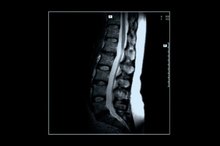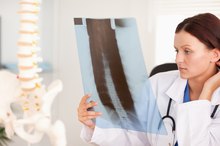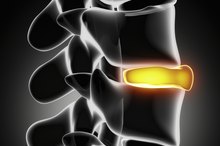What are the Problems After a Spinal Fusion of C-5 & C-6?
According to the to the Chicago Institute for Neurosurgery and Neuroresearch, the most frequently fused cervical segments are C5 and C6, and discectomy is the most common reason for this surgery. Generally, the cervical vertebrae are approached from the anterior surface, and after discectomy an anterior fusion is performed. The surgery usually requires grafting bone material into the disk space and then using metallic hardware to stabilize the bones and encourage fusion. This is a delicate surgery and not without potential problems.
If you are experiencing serious medical symptoms, seek emergency treatment immediately.
Fusion Problems
The objective of cervical spinal fusion is to stabilize the vertebrae so that they can grow together over time so that they no longer move relative to one another 2. Fusion is encouraged by grafting bone from the patient’s hip to the intervertebral space. Also, donor material or artificial bone can be used. However, for unknown reasons fusion sometimes fails. A 2009 article in the journal "Applied Radiology" states that this is a major problem with fusion surgery, especially in older patients and those who smoke. Non-fusion results in a pseudarthrosis, where the vertebrae remain as two separate bones. In a similar circumstance, the bones fuse but they place mechanical loads on the vertebrae above and below the fusion. The result can be disk pathology and arthritis in these segments. This problem occurs in about 10 percent of cases, according to the journal.
- The objective of cervical spinal fusion is to stabilize the vertebrae so that they can grow together over time so that they no longer move relative to one another 2.
- In a similar circumstance, the bones fuse but they place mechanical loads on the vertebrae above and below the fusion.
Hardware Problems
Complications With an L5-S1 Spinal Fusion
Learn More
This can result in a pseudarthrosis that may require another surgery to repair or to replace the hardware. In the 2009 journal article in "Applied Radiology," doctors report that the metal hardware can also irritate the tissues next to it, resulting in cavity formation, pressure sores and pain. In addition, the bone around the hardware can erode or resorb. The result is vertebral bone weakening which can cause the bone to fracture, necessitating another surgery to remove the hardware. The hardware can also cause neurological damage. This occurs when part of the hardware breaks or slips and then impinges on the spinal cord or spinal roots. The result can be motor or sensory loss which might manifest as pain, weakness, desensitized touch, and bowel or bladder problems.
- This can result in a pseudarthrosis that may require another surgery to repair or to replace the hardware.
- In the 2009 journal article in "Applied Radiology," doctors report that the metal hardware can also irritate the tissues next to it, resulting in cavity formation, pressure sores and pain.
Other Problems
MedlinePlus, a service of the National Institutes of Health, states that other problems can be associated with cervical spinal fusion surgery such as infection in the vertebral bone or in the operated area 2. However, such infections are usually successfully treated with antibiotics. Another problem is that the bones above and below the vertebrae that were fused can cause pain. Other problems such as blood clots and deep vein thrombosis can be painful and deadly if they migrate to the brain or lungs. Also, this and any surgery can result in bleeding and a pulmonary embolism.
- MedlinePlus, a service of the National Institutes of Health, states that other problems can be associated with cervical spinal fusion surgery such as infection in the vertebral bone or in the operated area 2.
- Also, this and any surgery can result in bleeding and a pulmonary embolism.
Related Articles
References
- “Applied Radiology”; Diagnostic imaging of spinal fusion and complications; M. Hayeri and J. Tehranzadeh; July 2009
- MedlinePlus: Spinal Fusion
- "The Spine Journal"; Complications of spinal fusion in treatment of adult spinal deformity; Dr. Jen-Yi Chang et al.; September 2002
- Mccartney S, Baskerville R, Blagg S, Mccartney D. Cervical radiculopathy and cervical myelopathy: diagnosis and management in primary care. Br J Gen Pract. 2018;68(666):44-46. doi:10.3399/bjgp17X694361
- Kelly MP, Eliasberg CD, Riley MS, Ajiboye RM, Soohoo NF. Reoperation and complications after anterior cervical discectomy and fusion and cervical disc arthroplasty: a study of 52,395 cases. Eur Spine J. 2018;27(6):1432-1439. doi:10.1007/s00586-018-5570-8
- Rhee JM, et al. Cervical radiculopathy. J Am Acad Orthop Surg. 2007;15:486-94.
Resources
Writer Bio
Dr. Christian Walker began writing professionally in 1982. He has published in the fields of surgery, neurology, rehabilitation and orthopedics, with work appearing in various journals, including the "Journal of the American Osteopathic Association" and "European Neurological Society." Walker holds a Doctor of Philosophy in medical physiology from the University of Medicine and Dentistry of New Jersey.









